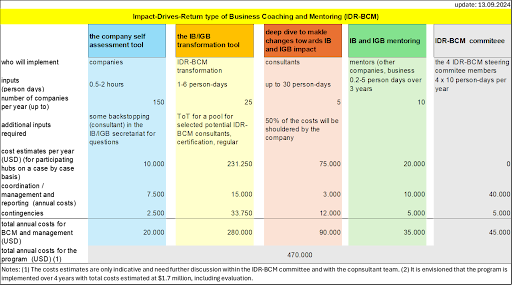Business coaching and mentoring under an impact drives return approach
Mainstream business development services:
To promote enterprise development, many institutions from government, business associations, development partners and business facilitators finance programs for business development. Most of these programs are training courses for start-up firms, emphasizing basic business knowledge around the business establishment and value chain analysis frameworks or through people-centered business approaches (among many others). There are many training courses for micro and small enterprises, implemented by NGOs or start-up support consulting firms. In addition, medium and larger companies pay for specialized one-on-one business coaching to enhance their commercial viability or to explore new markets, get advice on internal restructuring, merger and acquisition, or recommendations for cost saving mechanisms.
Business advisory tools on how to make IB/IGB are missing:
The traditional business advisory tools do not specifically focus on the social impact of firms, nor on how more social or environmental impact can dynamize also more business returns The IB/IGB literature is mainly descriptive in showing good examples, although some studies (esp. from IFC) and a few consulting firms (Hystra, ENDEVA, BoP Inc) synergize learnings.
While there are tools to measure impact, these are typically used at portfolio level and are not necessarily designed as a dynamic instrument to inform the company enhancing its business performance through achieving more social impact. For companies in the growth phase that wish to combine social impact and commercial viability, specific business coaching tools on designing for where impact that thrives commercial return and vice versa are missing.
Business schools increasingly offer courses on environmental sustainability and adherence to social safeguards, but not (yet) on developing IB/IGB business models. Such tools would need to explain how a company can transform its current business model into an IB, how an NGO-driven social enterprise can transform into an IB initiative, how a corporate social responsibility can be made an IB activity.
The IB-BCM tool has 4 components:
- The IB/IGB readiness assessment tool is a succinct help for self-assessing a company whether its business would perhaps qualify as IB/IGB and which specific areas of the business needs improvement to become a real IB/IGB. The tool can also be used by government, business associations and development partners implementing portfolios for micro and SME support, value chain development to focus their programs better on achieving systemic and deliberate (not trickle-down) results for poverty reduction and social inclusion, while at the same time enhancing commercial viability and business growth. Such tool would require per company perhaps 30 minutes assessment through a flow. The subtool 1 is further described
2. The second component is the IB/IGB transformation tool. This tool implemented by business facilitators (consultants) to help interested companies with IB/IGB potential making the transition from
- From a mainstream business to an IB/IGB-model, or
- From a corporate social responsibility (CSR) work stream to a core-business commercial IB activity with much larger and more sustainable impact, or
- From a NGO driven social enterprise (with small social reach and low commercial viability if at all) to a scaling IB initiative, or
- From an IB/IGB model to a much better IB/IGB model with higher and deeper and more transformative impact and better commercial viability and returns.
- The tool would be used by specifically trained IB/IGB business advisory service consultants; it can also be used by mainstream business consultants who have undergone additional training and would use the tool as part of their ordinary business services. Typically, IB/IGB transformation ends with an advisory note giving clear directions for IB/IGB transformation as agreed with the firm. Two to six person-days of dedicated discussions with the company would be required in an intensive and focused one-on-one discussion with the firm. The subtool 2 is further described
3. The third tool is for IB/IGB deep dive. This tool will help consultants orienting their specific advisory support to create more social or environmental impact. It is a financing facility for preparing – for example: (a) a revised business plan, or (b) a market assessment, or (c) a re-orientation of the input sourcing, or (d) a social or environmental impact assessment coming up with clear recommendation to implement changes in the business line for achieving impact for the BoP and the environment/climate, or (e) recommendations for company internal institutional reforms on the way to become IB/IGB, or (f) for institutionalizing impact monitoring and reporting, Such deep dive support would be typically 15-40 person-days of expert inputs. It would be given only to companies with business lines already accredited as IB/IGB.
4. The fourth tool is for IB/IGB mentoring. It is developed particularly for business associations with mentorship programs, and would help those associations and their consultants adding IB/IGB advise to their mentorship programs and thus achieving more social impact and higher business returns at the same time. Specific advisory suggestions will be developed for different stages of IB/IGB mentorship over a 2-3 year program per company. The tool 4 is closely linked to the structure and content of tool 2; however it would have more business case examples for the mentor to draw on. The IB/IGB mentorship program would have a back-up expert, to whom the mentors under the business associations can seek advice on IB/IGB related questions emerging in the discussions with the mentored companies.
The chart gives an overview of the 4 tools, the implementation structure, number of firms benefitting and costs per year. In addition to the outputs and costs indicated therein, i.e. costs which are proposed to be provided through the IB/IGB support program, addition inputs will come from the multiple stakeholders.


